
PRUSSIA – AUTOGRAPHED POSTCARD – PRINZ OSKAR von PREUßEN
This postcard has been autographed by Prinz Oskar von Preußen. He was one of Kaiser Wilhelm II’s six sons…..

This postcard has been autographed by Prinz Oskar von Preußen. He was one of Kaiser Wilhelm II’s six sons…..
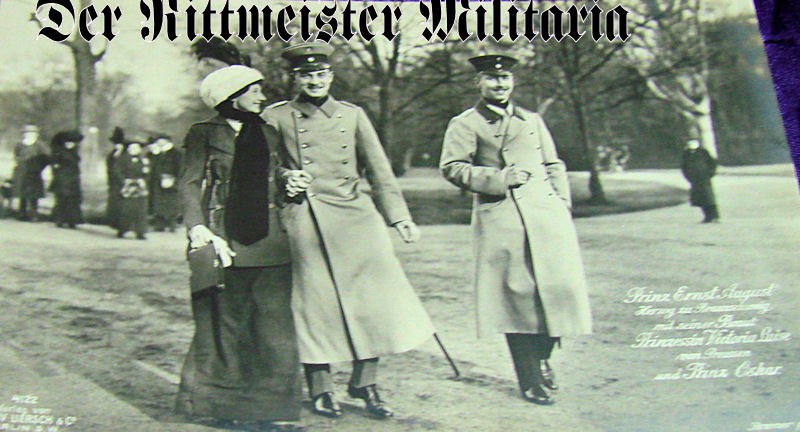
This postcard shows the Duke of Braunschweig, Ernst August, his wife Viktoria Luise, the former Princess and Kaiser Wilhelm II’s daughter, and Prinz Oskar of Prussia, Viktoria Luise’s brother. The postcard was not mailed.
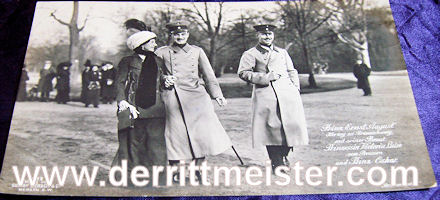
This postcard shows Duke Ernst August of Braunschweig (1887-1953) and his wife, the Duchess. He was married to Kaiser Wilhelm II’s daughter, the former Prinzessin Viktoria Luise (1892-1980). Their 1913 marriage brought Braunschweig back under its own duke’s direct rule for the first time since Braunschweig was absorbed by Prussia after the 1866 Austro-Prussian War. The Duke is seen here with his young bride and her brother, Prinz Oskar of Prussia. The postcard was mailed in 1913, the year of their marriage.
This postcard shows Prinz Oskar of Prussia (1888-1958) one of Kaiser Wilhelm II’s sons. Beside him is his wife, Gräfin Ina von Ruppin. Prinz Oskar is wearing the 1. Garde-Regiment zu Fuß’s uniform. He also wears the 1914 Iron Cross 1st and 2nd Class. The postcard was not mailed.
This postcard shows Prinz Oskar of Prussia (1888-1958). He is with his wife and infant child.
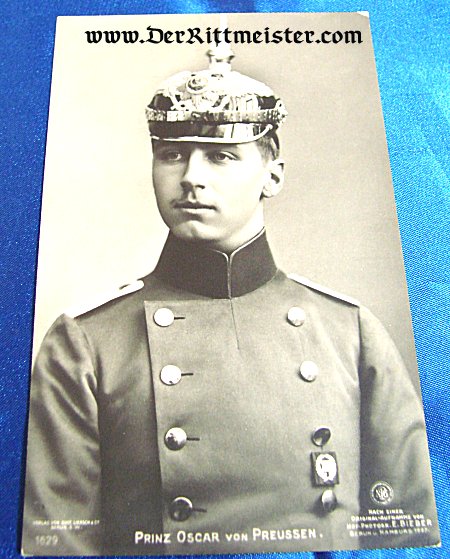
This is an interesting pose of Prinz Oskar of Prussia. Oskar was another of Kaiser Wilhelm II’s sons. He is wearing the uniform of a leutnant and the pickelhaube of an officer in 1. Garde-Regiment zu Fuß. This photo was taken well before the beginning of WW I.
This postcard shows one of Kaiser Wilhelm II’s sons, Prinz Oskar (1888-1958). He appears with his young bride, Gräffin Ina von Ruppin. This was not mailed.
This postcard shows Prinz Oskar’s young wife (Oskar was one of Kaiser Wilhelm II’s sons). She has their three children gathered about her. The postcard was not mailed.
This postcard shows Kaiser Wilhelm II’s son, Prinz Oskar of Prussia. He appears with his wife and infant son. The postcard is dated and was not mailed.
This postcard show Prinz Oskar of Prussia, along with his wife. He is wearing the M-1910 feldgrau tunic of 1. Garde-Regiment zu Fuß. On his tunic he is wearing the 1914 Iron Crosses 1st and 2nd Class.
This postcard shows Prinz Oskar (1888-1958) of Prussia. He was the fifth of Kaiser Wilhelm II’s six sons. He is seen in a M-1915 feldbluse for 1. Garde-Regiment zu Fuß. He is wearing a neck order, breast star, etc.
This postcard shows Prince Oskar of Prussia and his wife. He is in uniform. The postcard was not mailed.
This postcard shows Prince Oskar of Prussia and his wife. He is in uniform. The postcard was not mailed.
This postcard shows Prince Oskar of Prussia and his wife. He is in uniform. The postcard was not mailed.
This postcard shows Prince Oskar of Prussia and his wife. He is in uniform. The postcard was not mailed.
This postcard shows Prinz Oskar, who was one of Kaiser Wilhelm II’s six sons. He is in a business suit with his three young children gathered around him.
This postcard shows Prinz Oskar and his young family. This postcard was produced by Gustav Liersch. A rubber stamp from that firm is on the reverse. The postcard was not mailed.
This postcard shows a very young Prinz Oskar, with his two older brothers, Prinz Adalbert, and Prinz August Wilhelm. Prinz Oskar is so young that he was dressed much like a girl, as was the custom of the day. He has very long hair and wears what today we would consider a dress. The postcard was not mailed.
This postcard shows a very young Prinz Oskar and his brother Prinz Joachim. Both youngsters are dressed in kilts representing a Scottish regiment or organization. Standing with the two boys is a very young Prinzessin Viktoria Luise. The postcard was not mailed.
This postcard shows Prinz Oskar of Prussia in a feldgrau uniform (feldbluse) and schirmütze. He has several decorations pinned to his tunic, including a Black Eagle Breast Star and a 1914 iron Cross 1st Class. He also has a large ribbon bar. The postcard was not mailed.
This is a wonderful postcard showcasing Prussia’s Prinz Oskar. He is dressed in a 1. Garde-Regiment zu Fuß leutnant’s full dress uniform, including the regiment’s mitre. He also wears a kette around his neck, a breast star, a Kaiser Wilhelm II adjutant’s badge, and a medal bar. The postcard was not mailed.
This postcard shows Prinz Oskar of Prussia, his wife, and four children. They are all in casual clothing. From the looks of it, the photograph was taken after WW I. The postcard was not mailed.
This postcard shows Prinz Oskar of Prussia and his wife. They are standing in a garden. He is dressed in an überrock. He is also wearing a schirmütze. The postcard was not mailed.
This postcard shows Prinz Oskar of Prussia and his wife. They are standing in a garden. He is dressed in an überrock. The postcard was not mailed.
This postcard shows Prinz Oskar of Prussia and his wife. They are standing in a garden. He is dressed in an überrock. The postcard was not mailed.
This postcard shows Prinz Oskar of Prussia and his wife. They are standing in a garden. He is dressed in an überrock. The postcard was not mailed.
This postcard shows Prinz Oskar of Prussia and his wife. Oskar’s father, Kaiser Wilhelm II, opposed the marriage because she did not come from a proper royal family. She was never afforded the title of Princess, and instead was given the title of Gräffin (Countess). It spite of that, the couple appeared to be quite happy. [Kaiser Wilhelm also opposed Crown Prince Wilhelm eldest son’s marriage (he was also named Wilhelm). Again, the young man followed his heart and married the woman of his choice rather than whom his grandfather wanted. The younger Wilhelm was an army member and was killed fighting in France during 1940].
This photo was from WW I, as Prinz Oskar displays 1st and 2nd Class Iron Crosses on his tunic. He is wearing the 1. Garde-Regiment zu Fuß’s uniform. The postcard was not mailed.
Prinz Oskar was one of Kaiser Wilhelm II’s six sons. He is seen here during WW I with his wife, Gräfin Ina-Marie von Ruppin. He is wearing both the 1st and 2nd Class 1914 Iron Crosses.
This postcard shows one of Kaiser Wilhelm II’s six sons, Prinz Oskar (1888-1958). The pose dates from WW I. He is wearing an overcoat with the 1914 Iron Cross 2nd Class ribbon in its buttonhole.
This postcard shows Prinz Oskar (1888-1958) of Prussia. He was the fifth of Kaiser Wilhelm II’s six sons. He is seen in a M-1915 feldbluse for 1. Garde-Regiment zu Fuß. He is wearing a neck order, breast star, etc.
Princess Viktoria Luise of Prussia is riding with her older brother, Prince Oskar. The postcard was not mailed.
This postcard shows the Duke and Duchess of Braunschweig, walking with her brother, Prinz Oskar of Prussia. The two men are wearing military overcoats. The postcard was not mailed.
This postcard shows Prinz Oskar (1888-1858) of Prussia’s wife along with two of their sons. She was officially known as Gräffin Ina von Ruppin. Wilhelm II was not happy with his son’s choice, because she was not placed high enough among German royalty. Oskar proceeded with the marriage anyway. This was not mailed.
This postcard shows Prinz Oskar (1888-1858) of Prussia’s wife. She was officially known as Gräffin Ina von Ruppin. Wilhelm II was not happy with his son’s choice, because she was not placed high enough among German royalty. Oskar proceeded with the marriage anyway. This was not mailed.
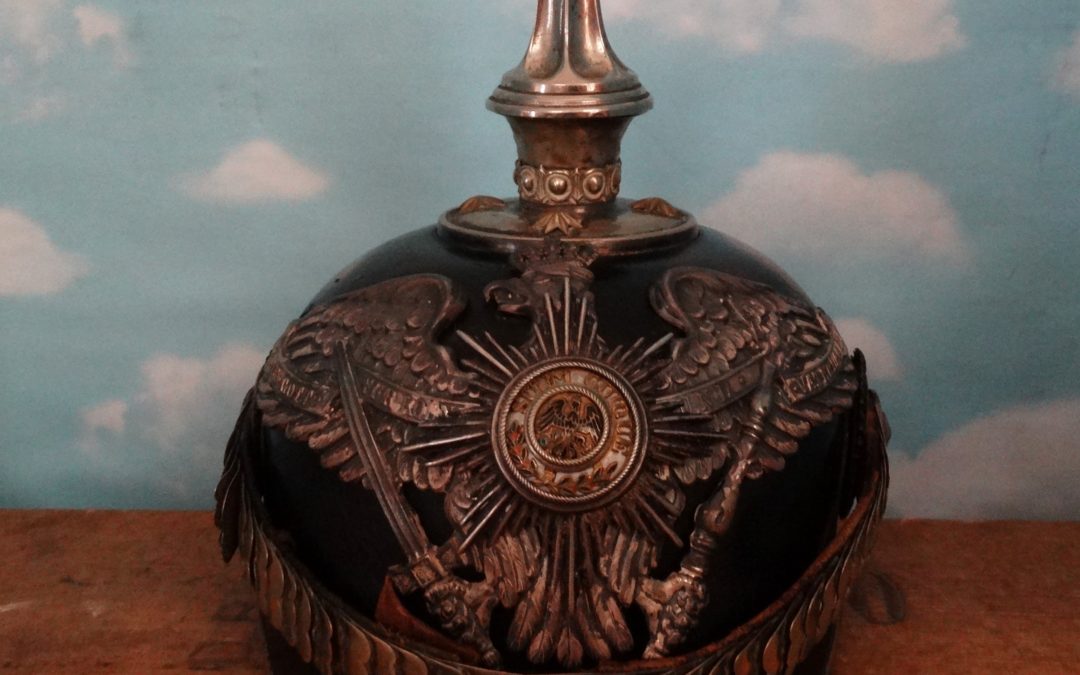
This is a simply delicious 1. Garde Regiment zu Fuß officer’s spiked helmet. The regiment was the most elite among Prussia’s and Germany’s Infanterie Regiments. It was garrisoned in Potsdam with its Kavallerie Regiment counterpart, the Regiment der Garde du Corps. The regiment was loaded with denizens of Imperial Germany’s highest royal and noble families. Every Hohenzollern Prinz was invested in it, including all of Kaiser Wilhelm II’s sons, just as the Kaiser himself had been as a young man. The Kaiser also served as its Regimental Chef……

This is an interesting photograph of Kaiser Wilhelm II and a group of family and friends. Among those in the photo include his son Prinz Oskar along with his wife and his second wife Hermine….
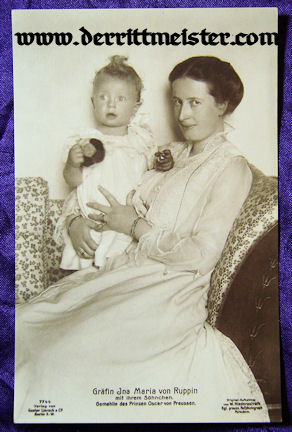
This postcard shows the Gräfin Ina Marie Rupin (1888-1973). She was married to Prinz Oskar (1888-1958), one of Kaiser Wilhelm II’s sons. She was the Countess von Bassewitz when she married Oskar. Her marriage to Oskar thus was morgantic, meaning neither she nor her children could become full-fledged princesses or princes. Instead, she was created Gräfin Ina Marie von Rupin. In 1920 she was named a princess with its full rank and privileges. Her children were granted these rights, as well.

GROßADMIRAL’S SHIP’S FLAG WITH STORAGE BAG.
This is a consignment item. The Kaiserliche Marine (and its improvement) was a project close to the hearts of Kaiser Wilhelm II and the Imperial German Navy’s Secretary of State, Alfred von Tirpitz. As Queen Victoria of England’s eldest grandson (Wilhelm’s mother was Victoria’s eldest daughter), Wilhelm spent a good part of his childhood visiting England and hobnobbing with his many royal British relations. His regard for his grandmother’s naval forces eventually became a passion for Germany to equal and SURPASS his British cousin’s Royal Navy. Under Wilhelm II and von Tirpitz a massive build-up took place that saw the Kaiserliche Marine’s scope greatly advance. No matter how many ships Germany built, however, England continually raised the ante by producing more ships with much-improved designs. Germany had spent much of the 18th and 19th Centuries struggling to unite its many small states and kingdoms, and fending off incursions from the likes of Napoleon, which left it little time to pursue foreign colonial expansion. By the time Germany finally consolidated into an empire, only a few small areas were available for colonization. Also, Chancellor von Bismarck had disdained colonial expansion, and had seen little need for a larger navy, which was one of the many reasons that von Bismarck found himself retired shortly after Wilhelm II ascended the Imperial throne!
Once he came into power, Wilhelm II wasted no time in expanding his beloved navy. Until 1901, the Kaiserliche Marine’s highest rank had been that of an Admiral, which was equivalent to a General der Infanterie. [The German Navy’s only three “Flag Ranks” were Konteradmiral, Vizeadmiral, and Admiral]. This meant the Navy had no rank equivalent to the Army’s Generaloberst or Generalfeldmarschall. Wilhelm changed the situation in 1901 by establishing the rank of Großadmiral and, unsurprisingly, naming himself the rank’s first recipient. From that time until the German Empire’s demise, a total of six men achieved the rank, (listed below).
1901 – Kaiser Wilhelm II (1859–1941)
1901 – King Oskar II of Sweden (1829–1907)
28 June 1905 – Hans von Koester (1844–1928)
4 September 1909 – HRH Prinz Heinrich of Prussia (1862–1929)
27 January 1911 – Alfred von Tirpitz (1849–1930)*
*[Promoted on an Honorary Basis w/o Patent, and thus not authorized to wear a Großadmiral’s crossed batons.
Instead, his shoulder boards and/or epaulettes displayed four pips].
31 May 1918 – Henning von Holtzendorff (1853–1919)
Our offering today is an ultra rare Großadmiral’s flag. [PLEASE NOTE: in the Kaiserliche Marine, an Admiral of any rank was considered a “Flag” officer. Thus he was permitted to fly “his” flag from any ship that he was stationed aboard or visiting. This was especially true when a Großadmiral visited a ship]. The flag is amazingly beautiful to look at. My imagination immediately whisks me to when it flew from a battleship hosting one of the Großadmirale (a rather infrequent occasion). The massive flag measures 87″ x 89″ (220cm x 225cm) and is made with two different types and weights of cotton. The flag’s bulk consists of very gauzy, lightweight cotton, which was necessary for such a large flag. When held up to the light, it appears almost opaque. The areas featuring the German cross sport a far heavier cotton to protect the overall design and promote an inherent sense of strength.
The flag’s center features the pair of crossed batons emblematic of a Großadmiral’s office and rank. [To view similar crossed batons, you can look at those on Kaiser Wilhelm II’s single shoulder board (click here to see) or those on Großadmiral Hans von Koester epaulettes (click here to see) Both are currently for sale]. A Großadmiral’s batons, whether on his shoulder boards/epaulettes or on the actual baton he carried, were totally different from those for a Generalfeldmarschall (and far more beautiful, in my opinion). At any rate, the flag’s batons are very large and beautifully detailed. They give the flag some vivid pops of color, including metallic gold, blue, and red. The metallic paint was applied by hand. The flag’s artwork is amazing. The time and effort that went into creating this breathtaking flag had to have been considerable.
Many different sections of the flag do display stains. I do not know what caused them, but they appear across the flag. The flag shows MINIMAL mothing. NO markings whatsoever are present on the flag’s bunting. Two attachments for the lanyards necessary for when the flag was flown are present. Its storage bag is made from lightweight canvas and measures 11 ½” x 42.” The bag is dingy with age and has several holes and rust stains at its base. The base is held together by a metal clip in its center.
The flag is in surprisingly good condition, considering its age, size and the materials from which it was constructed. The consignor tells us that the auction house from which he purchased the flag stated that it had belonged to Großadmiral von Holtzendorff. No provenance other than this information is available, however. It remains an amazing historical artifact.

This is a single Großadmiral’s shoulder board that once adorned Kaiser Wilhelm II’s uniform. Only six men achieved this exalted rank in the Imperial German Navy’s history. These men included:
1901 – Kaiser Wilhelm II (1859 – 1941)
1901 – King Oskar II of Sweden (1829 – 1907)
28 June 1905 – Hans von Koester (1844 – 1928)
4 September 1909 – HRH Prinz Heinrich of Prussia (1862 – 1929)
27 January 1911 – Alfred von Tirpitz (1849 – 1930)*
*[Promoted on an Honorary Basis without Patent, and thus NOT
authorized to wear his shoulder boards with the crossed batons
(the other five recipients could do so).]
31 May 1918 – Henning von Holtzendorff (1853–1919)
A Großadmiral’s rank in the Kaiserliche Marine was equivalent to that of a Generalfeldmarschall in the German Army, hence the use of crossed batons. The shoulder board is massive, measuring 2 ¼” x 5 .” It sports two gold bullion braids sandwiching a center silver bullion braid as the primary background. The silver bullion braid sports black chevrons that identify it as a naval shoulder board, since the Navy was part of the Reich (Empire) [not even such a mighty Kingdom as Prussia had possessed a Navy]. A magnificent set of crossed 2 ¼” Großadmiral’s batons is installed on the gold/silver bullion ropes. [Full-sized batons were issued to any man who achieved this rank, with the owner’s name noted on each one. Also please note: although the Großadmiral’s shoulder board batons have the same measurements as those on a Generalfeldmarschall’s shoulder board, the similarity ends there]. The Großadmiral batons’ attention to detail is amazing. If you look closely, you can see Prussian Crowns AND fouled Navy anchors! Instead of being silver, they are painted in THREE colors. Their primary background color is dark copper enamel, although much of it has worn off to reveal the gold beneath. The Hohenzollern Eagles and anchors are painted/enameled gold. Each baton tip is also gold with a small band of white enamel just below it.
The sumptuous detailing just keeps on coming! Kaiser Wilhelm II’s royal cypher is laid over the batons, with a beautiful Prussian Crown directly above it. Both are rendered in subdued brass that blends attractively with the batons. The obverse’s final item is a gilt-toned naval button displaying a crowned, fouled anchor. The reverse features a fine, dark-blue felt underlay, which ALWAYS appears on any Navy officer’s shoulder board. Some very light mothing shows on the fabric. An unusual circular brass backing plate holds the naval button in place.
Although we have offered Kaiser Wilhelm II’s shoulder boards in the past, this may be our rarest example yet!
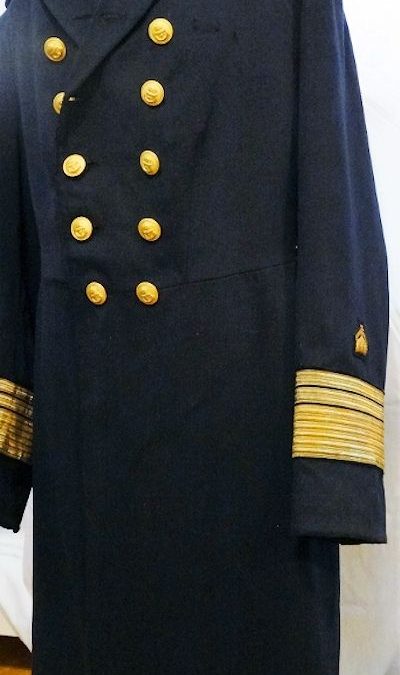
This is an amazing find for us at Der Rittmeister Militaria. Today we are offering a very special, full Admiral’s überrock. Finding tunics for General Officers is a hard task, although we are proud that our current inventory boasts tunics or complete General’s uniforms for Prussia, Württemberg, Saxony, and Braunschweig. Finding tunics for Kaiserliche Marine Admiräle is indeed a daunting task. Even tunics for junior officers are NOT easy to find. [We were blessed in the past to offer none other than Großadmiral Prinz Heinrich of Prussia’s überrock].
The Kaiserliche Marine possessed only four Admiräle levels. Unlike the Imperial German Army, which featured five Generals’ levels, the Navy did not sport a Generaloberst’s equivalent (the Army’s Generaloberst being its highest rank). The Navy Admiräle ranks included the four positions listed below, in lowest-to-highest order.
Konteradmiral
Vizeadmiral
Admiral
Großadmiral
For the most part, Admiral was the Kaiserliche Marine’s highest operational/tactical rank. Of the six men who achieved the Großadmiral’s rank, only ONE actually commanded fleet operations: Prinz Heinrich, Kaiser Wilhelm II’s younger brother. He commanded activities in the Baltic during WW I, and did not achieve his rank until 1909. The rest of the six included two who commanded the overall Kaiserliche Marine (Alfred von Tirpitz [1911] and Henning von Holtzendorff [1918]), and whose official titles were “State Secretaries of the Imperial Navy Office.” Another, Hans von Koester, received the rank in 1905, primarily as a thank-you when he was approaching retirement. The final two recipients were royals (Kaiser Wilhelm II and King Oskar II of Sweden), both of whom received the rank in 1901, the year in which it was originated.
So, a man who achieved an Admiral’s rank was a very high level naval officer who commanded great responsibility within the Kaiserliche Marine. Today, we are offering just such a man’s überrock. [The classic naval überrock was a frock coat that extended down its wearer’s legs, rather than stopping near the waist as did most tunics]. Our überrock is made from fine-quality, dark-blue, buttery-smooth wool. It sports a double row of gleaming gilt buttons (five-per-side) that run down the uniform’s center. The buttons display fouled anchors with Hohenzollern Crowns above them. The überrock’s left breast features a row of sewn-in loops for displaying a ribbon bar. The loops’ total width is 2.”
The shoulder boards are of the slip-on variety. Each features a small gilt Navy button, and the two silver pips typical of an Admiral’s shoulder boards. [It is one area where the Imperial German Navy’s shoulder boards differed from those belonging to the Army. For the Army, silver pips generally indicated an à la Suite officer, whereas gold pips signaled a staff or field-assigned officer. Navy shoulder boards were the exact opposite]. These shoulder boards feature “Russian rope” bullion, whose design displays alternating silver and gold rows. The silver bullion rope is imbedded with black chevrons. The shoulder boards have the dark-blue underlay characteristic of all Navy shoulder boards (a key point when confirming Navy status).
Each überrock sleeve displays a small gold bullion Hohenzollern Crown that measures 1 ” x 1 ½.” Each sleeve also reveals a wide gold bullion tape band that measures 2,” as well as two narrow gold bullion tape bands that each measure ” in width. It is here that we discover an anomaly. Two bands indicate a Vizeadmiral, while three stand for a full Admiral. I examined the shoulder boards closely, checking their size, fit, and etc. It is clear to me that they have been attached for a long time, and are NOT recent additions. [It is my view (and that of other knowledgeable collectors and experts) that the überrock’s owner never took the tunic to a tailor to have the other bullion band added after his promotion. As it is likely that a man of his rank owned several uniforms, it is quite possible our offering was an earlier tunic that he did not upgrade. He simply inserted the correct shoulder boards once he was promoted from Vizeadmiral to Admiral. Then he later purchased other tunics with the correct sleeve markings and shoulder boards].
The überrock’s reverse exhibits six more (three per side) large gilt buttons in its vent area. Its interior displays a magnificent, superior quality black silk lining. The inside lining possesses three large pockets. Two are slash examples, while the third is the more conventional vertical example. The entire liner is in excellent condition.
The überrock is in stunning condition, overall. We are pleased to share it with you today.
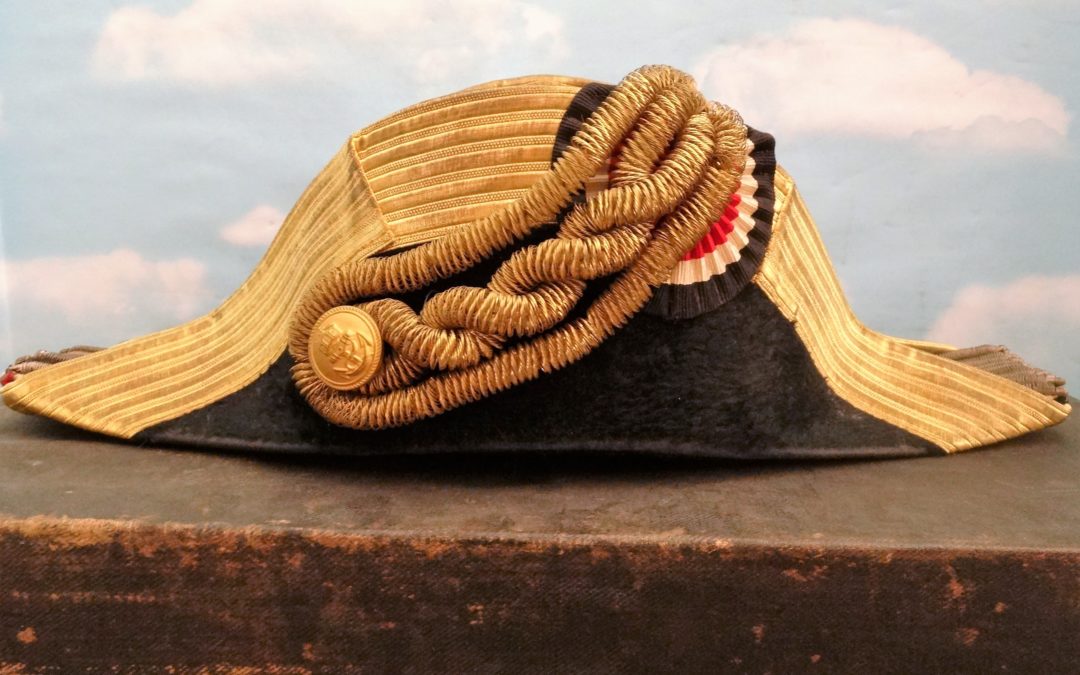
I first offered this group over a decade ago. The fellow who has owned it since then recently changed his area of interest, so I was thrilled to take it back in trade. (Items like this just do NOT become available often). Hans von Koester was one of six Imperial Period men (five Germans and one Swede) appointed as a Großadmiral. The rank was created in 1901, with Kaiser Wilhelm II (naturally) appointing himself the first rank holder. King Oskar II of Sweden was granted the same rank that year as a ceremonial gesture. Listed below are the six men who held the rank from 1901 until the empire’s end in 1918.
1901 – Kaiser Wilhelm II (1859–1941)
1901 – King Oskar II of Sweden (1829–1907)
28 June 1905 – Hans von Koester (1844–1928)
4 September 1909 – HRH Prinz Heinrich of Prussia (1862–1929)
27 January 1911 – Alfred von Tirpitz (1849–1930)*
[*Promoted on an Honorary Basis without Patent]
31 May 1918 – Henning von Holtzendorff (1853–1919)
The first two recipients were ceremonial appointments rather than direct commands. The third appointee, Hans von Koester, was the first “operational” admiral to receive the rank. He was promoted to Großadmiral in 1905 as a reward for his long service. He actually retired the following year (1906). The next to receive the rank was Prinz Heinrich, (one of whose tunics and officer’s summer schirmütze we are proud to offer). Heinrich held direct command in the Kaiserliche Marine and was a royal, so his appointment was not an à la Suite promotion. Heinrich was the second officer with a naval background to achieve the rank. Alfred von Tirpitz was the third.
*[PLEASE NOTE: von Tirpitz’s promotion must be viewed with an “asterisk.” His promotion was WITHOUT patent. That is, he was a Großadmiral in title, but his rank was more like that of an à la Suite (an honorary appointment for royalty ONLY). This somewhat confusing situation was evident on two different von Tirpitz shoulder boards we have offered in the past. Instead of a Großadmiral’s crossed batons, those boards displayed FOUR pips, which indicated the equivalent of a Generaloberst in the rank of Generalfeldmarschall. The latter was a rank often used by royals in the Imperial German Army, and officially WAS an à la Suite position. Prior to the institution of Großadmiral, the Imperial German Navy’s highest rank was a full Admiral, who wore TWO pips. The Navy had no equivalent to the Imperial German Army’s Generaloberst, who displayed THREE pips. The Navy simply skipped the rank! The number of shoulder board pips displayed on the four admirals’ ranks was as follows: a Konteradmiral wore NO pips; a Vizeadmiral displayed ONE pip; an Admiral boasted TWO pips; and a Großadmiral had NO pips, but instead displayed crossed batons].
The final man to achieve the rank was Henning von Holtzendorff. He assumed Alfred von Tirpitz’s role, and also did not exercise direct command after his promotion. In fact, he retired before the war’s end due to health problems (he died in 1919). Von Holtzendorff was replaced by Admiral Reinhard Scheer (the High Seas Fleet commander at 1916’s Battle of Jutland/Skagerrak). Scheer was responsible for running the Navy, but was NOT awarded a Großadmiral’s rank. The following small group of Großadmiral Hans von Koester’s personal effects is absolutely marvelous.
PAIR OF GROßADMIRAL’S EPAULETTES. I have seen some superb shoulder boards and epaulettes over the years, including those from the Kaiser. Nothing, however, has ever touched the sublime beauty of these truly magnificent specimens. Their centers are made of gold silk! Wool or felt is normally used for background material, not silk. Each center is highlighted by a pair of crossed batons. The batons’ artistry sets them apart from any Army Generalfeldmarschall’s batons. Army batons usually are made of silver, rather than the exquisite enamel used by the Navy. These display four different colors: gold, white, red, and black. Neither epaulette displays any damage whatsoever to these magnificent batons. A massive silver eagle grasping a fouled anchor in its claws overlays each baton set. Just below a small gilt naval button on the epaulette’s tongue is a silver Kaiser Crown. The tongue also displays red and black piping on a white background. The use of red, black, and white (the national colors) indicates that the Kaiserliche Marine was under the Reich’s authority, not the Kingdom of Prussia’s.
More gold design work extends out from the silk field on which the batons and eagles are mounted. Massive gold ringlets flow down majestically around their edges. (They must have looked amazing when worn on the dress uniform)! The epaulettes’ undersides are covered in navy-blue wool, another sure sign that they are correct for the Kaiserliche Marine. A sliding brass clip arrangement allows them to be slipped onto the tunic.
Looking at these epaulettes and their superb condition, one would be hard pressed to believe they are more than one-hundred-years-old.
GROßADMIRAL’S UNIFORM CUFFS. Imperial German Navy Admiräle uniforms displayed gold bullion stripes that indicated the man’s rank. Daily-use tunics did NOT display shoulder boards, so rank was determined by the number of stripes on the cuffs. In a Großadmiral’s case, FOUR stripes designated his rank. Each of these stripes measures 9/16″ in width. In addition to the rank stripes, a single wide band of gold bullion is present that measures 1 15/16″ in width. Its bullion displays a wonderful patina, with gentle toning. Each cuff normally had a bullion Kaiser Crown attached, as well. Only one of them is present, and is NOT attached to the cuff. [We will show this in our photographs]. Each cuff is wrapped very neatly in some very old tissue paper. Both are most attractive.
FORE & AFT CAP (ZWEISPITZ) BELONGING TO ADMIRAL HANS von KOESTER. Naval officers wore two types of headdresses. First, for regular duty, was the schirmütze (visor cap). Second, for more formal occasions, and often worn with a Gala Naval Uniform, was the zweispitz (fore and aft cap). [Naval officers actually had three types of uniforms: daily wear, dress, and high-dress (Gala). Many officers did not even have a Gala uniform unless they were of higher rank or were extremely wealthy]. In the USA, we more frequently associate fore and aft caps with naval headdresses from the 18th and early 19th Centuries. In the Kaiserliche Marine, an Admiral’s zweispitz was different from the other officers’ headdresses. Von Koester’s zweispitz is significantly and magnificently more elaborate.
The zweispitz’s body is covered with close-cropped very fine fur, perhaps seal. In addition to the golden coil that extends from the gilt navy button on the cap’s right side, the other huge difference is a 2 ½”bullion band that runs the length of the cap’s two sides. Each of the cap’s ends sports multiple silver bullion ringlets. Beneath the top row of silver ringlets is another row that is interspersed with silver, red, and black ringlets. The cap’s right side boasts a large and very elegant silk Reich’s kokarde.
Turning to the interior, we see a very high-quality, light-brown leather sweatband. It is 100% complete and in excellent condition. If we look closely, in a place or two we can see some very slight sweat stains from where von Koester actually wore it! The white silk liner is flawless and in superb condition. His name, “von Koester,” is embossed in gold on the white silk liner.
STORAGE CASE FOR ALL ITEMS LISTED ABOVE. This is a large storage case that measures 8 1/4″ x 9″ x 18.” The case was used to store the epaulettes and zweispitz when not in use. It has a handle on the top that made it convenient for use when traveling. On the case’s front is a small plaque that measures 1 3/16″ x 3 ½” and bears his name: “von Koester.” When I originally bought the group many years ago, the case’s top half was separated from its bottom half. The hinges and screws that secured them had pulled loose. When I bought the group back, I decided to address the problem. Normally, I prefer to avoid restoration, but in this case I felt it was in order. So we inserted new screws in the original hinges and the case operates as it did more than one-hundred-years ago. The original key is attached to the handle!
Inside the case we see that the zweispitz is nestled at the bottom. Over it is a red silk platform. The platform performs two purposes. It separates the zweispitz from the contents at the case’s top. That is where the platform becomes the epaulettes’ storage stand. Each epaulette slides onto the platform and is secured. The tunic cuffs are folded in their tissue and laid at the top, which makes for a tidy package.
SILVER PRESENTATION PLATE FROM von KOESTER’S STAFF WHEN COMMANDER OF DER MARINE STATION den OSTSEE. This is an ultra-high-quality silver presentation plate. It measures 11″ in diameter. The plate’s edges display very elaborate scrollwork accented with a floral motif. The following dedication is engraved at the plate’s top: “Unserem Hochverehrten Stationschef Admiral H. Koester” (Our esteemed station-chief Admiral H. Koester). Another engraving is presented at the plate’s bottom: “Die Offiziere der Marinestation der Ostsee” (The officers of the Baltic Sea Marine Station). An admiral’s flag is in the plate’s center. Below that is the presentation’s date, 22 März 1897. The plate’s reverse is highly tarnished and bears the manufacturer’s hallmark, as well as one for .800 silver, and the initials “AP.”
The Marinestation Ostsee was the Baltic Sea Naval Station located in Kiel. Von Koester held this post from 1889 to 1903. It should also be noted that he is recognized as an Admiral, rather than the lower rank of Vizeadmiral. It is interesting to note that von Koester received the promotion in 1897, the same year as the plate! The plate is in amazing condition for its age.
COLOR POSTCARD AND DETAILED HISTORICAL INFORMATION OF HANS von KOESTER. We are including a period color postcard of Großadmiral Hans von Koester. We thought it important that you know what the man looked like. We also have some historical background on him that chronicles his long career.
Words cannot adequately describe the beauty, rarity, and historical importance of this group. If you are a collector of Kaiserliche Marine items, we have many other important items including Prinz Heinrich’s aforementioned group, an overcoat with shoulder boards for a Großadmiral, and numerous epaulettes for every officer rank up-to-and-including a Kapitän zur See. (Please browse our “NAVY” Merchandise Page to see them, click here to see).